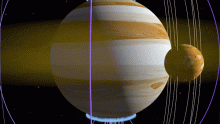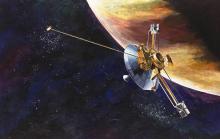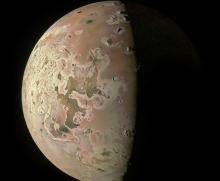Listen to today's episode of StarDate on the web the same day it airs in high-quality streaming audio without any extra ads or announcements. Choose a $8 one-month pass, or listen every day for a year for just $30.
You are here
Moon and Companions II
The Moon is continuing to run the gauntlet of planets in the early morning sky. Over the next couple of days it’ll team up with the two brightest planets of all, Venus and Jupiter. They’ll stand close to the left of the Moon at first light tomorrow, and just above the Moon on Wednesday. Fainter Mars will stand to their upper right, with Saturn farther still.
Venus is the brightest of the four planets. Its brilliant appearance is the result of its closeness to Earth and the Sun, and to the bright clouds that completely blanket the planet. The clouds are made mainly of sulfuric acid, which makes it tougher for spacecraft to drop through them. Several probes have survived the passage, though, and either landed on the surface or floated below the clouds.
Jupiter is the next-brightest planet. It’s hundreds of millions of miles farther out in the solar system. But it’s also the biggest planet. And it, too, is covered by brilliant clouds. In Jupiter’s case, though, the clouds are made mainly of water and ammonia. Only one probe has dropped into the clouds. But there’s no solid surface to land on, so the probe was destroyed by high temperatures and pressures as it descended.
Venus and Jupiter are moving closer together, and will make their closest approach to each other in less than a week — a spectacular encounter between cloudy planets.
We’ll have more about this beautiful morning line-up tomorrow.
Script by Damond Benningfield





